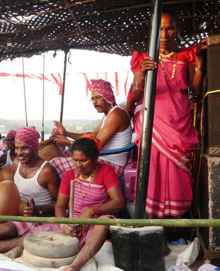Kudumbi
 From Wikipedia the free encyclopedia
From Wikipedia the free encyclopedia
| Kudumbi | |
|---|---|
| Classification | Farmers, cultivators |
| Religions | Hinduism |
| Languages | Konkani, Malayalam |
| Populated states | Kerala |
| Ethnicity | Kunbis of Goa |
The Kudumbi, also referred to as the Kunubis, the Kurumbi, or the Kunbi, are traditionally a Konkani-speaking farming community residing in Kerala, India.[1][2]
History[edit]
Goan legacy[edit]
According to Goan historian Anant Ramakrishna Dhume, the Kunbi caste are modern descendants of ancient Mundari tribes. He refers to several words of Mundari origin in the Konkani language and also elaborates on the deities worshipped by the ancient tribe, their customs, methods of farming, etc.[3][full citation needed] G. S. Ghurye says that "Kurmi, Kanbi and Kunbi perhaps signify the occupation of the group, viz., that of cultivation, though it is not improbable that the name may of tribal origin."[4]
The Kudumbi were forced to migrate from Goa following religious persecution by the Portuguese during the Goa Inquisition, which sought to suppress Hinduism. The Kudumbis, along with Gouda Saraswat Brahmins, Daivajnas and Vaishya Vanis who wanted to preserve their religious and cultural identity, migrated from Goa along the west coast of India, primarily through sea voyages.[citation needed]
Some of the groups that fled Goa landed in coastal districts of state of Karnataka, that is, the Uttara Kannada, Dakshina Kannada and Udupi districts, and some groups voyaged further to Kerala.[5][full citation needed][need quotation to verify]

Current status[edit]
K. R. Gowri Amma, a prominent figure in the communist movement in Kerala and former Minister, in her autobiography narrates the backwardness of Kudumbi Community as:
In the socio-political and in educational fields, the Kudumbis are backward. Very few of them are educated and officers are scarce. Kudumbi women do not wear a blouse but wrap the sari, sarong wise about them. In 1936, an association of young Kudumbis was established in Cochin and later in Travancore. In 1951, the two associations merged into one. Yet they have not achieved their rightful place in society. They have demanded that they be counted as scheduled castes. In reality their lot is worse than that of the scheduled castes.[6][full citation needed]
V. K. Valath says that the main agricultural labourers in the islands around Kochi have been from the Pulaya and Kudumbi castes. He adds that, whilst many people of the Pulaya and Mukkuvar castes converted to Christianity during the Portuguese period, the Kudumbis retained their traditional religious beliefs.[7][page needed][need quotation to verify]
The community is officially classified as being within the Socially and Economically Backward Communities (SEBC).[8]
Kudumbi temples[edit]
Holi, the festival of colors, is celebrated in many Devi temples by the Kudumbi.[9]
See also[edit]
References[edit]
- ^ Loes Ch. Schenk-Sandbergen (1988). Poverty and survival: Kudumbi female domestic servants and their households in Alleppey, Kerala. Manohar Publications. p. 37. ISBN 9788185054551.
- ^ Georges Kristoffel Lieten; Olga Nieuwenhuys; Loes Ch. Schenk-Sandbergen; Werkgemeenschap Zuid-Azië (1989). Women, migrants, and tribals: survival strategies in Asia. Manohar Publications. p. 124. ISBN 9788185054773.
- ^ Dhume, Anant Ramkrishna (1986). The cultural history of Goa from 10000 B.C.-1352 A.D.(see pages 53, 94, 83, 95)
- ^ Ghurye, G. S. (1969). Caste and Race in India. Popular Prakashan. p. 31. ISBN 9788171542055.
- ^ Rao, Y.R. (2003). Tribal Tradition and Change: A Study of Kudubis of South India. Mangala Publications. ISBN 9788188685004.
- ^ 'Atmakatha', by K R Gouri Amma
- ^ V. V. K. Valath (1991). Keralathile Stala Charitrangal, Eranakulam Jilla. Second Edition, 2006, published by Kerala Sahitya Academy.
- ^ SEBC list of Kerala State Govt
- ^ "Holi, Kerala style". The Hindu. 7 March 2004. Archived from the original on 13 April 2004. Retrieved 6 May 2015.
Sources[edit]
- The Kurmis-Kunbis of India by Pratap Singh Velip Kankar. Published by Pritam Publishers PajiFord, Margoa, Goa Year −2006.
- 1956 An Introduction to the Study of Indian History (Popular Book Depot, Bombay) – D.D. Kosambi.
- Kudumbikalude Charithravum-Samskaravum – written by Dr. Vini M. Published by Sahithya Pravarthaka Cooperative Society, Kottayam, Kerala